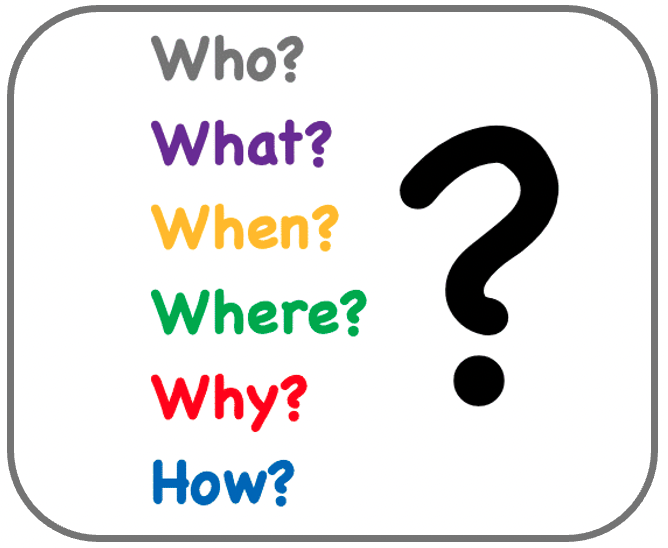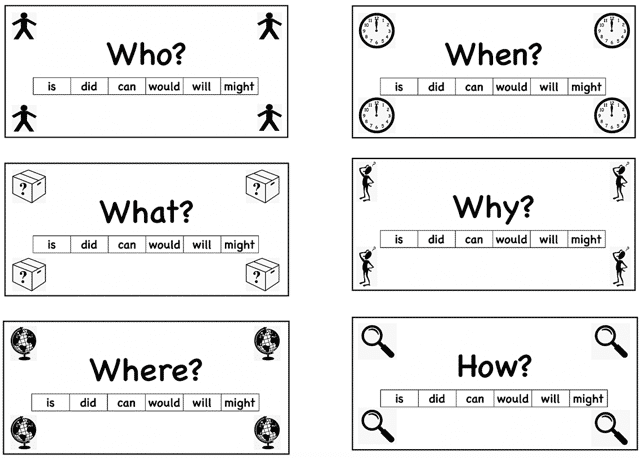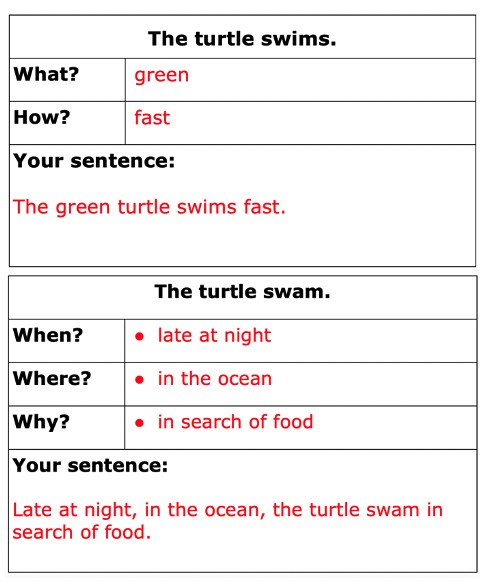Teaching with “W” Questions

The “W” questions — who, what, when, where, why, how — are small but powerful words that can be used in a number of ways to develop early elementary students’ literacy skills, including oral language and discussion skills, reading comprehension, and writing skills.
Oral Language, Discussion Skills
Many younger students in the primary grades do not regularly speak in full sentences or elaborate their ideas when they share with others in conversation. Students can use “W” questions to develop speaking and listening skills. Common Core Reading Standard #1 notes that by the end of grade 2 students should be able to ask and answer who, what, where, when, and how questions to demonstrate understanding of key details in text.
A set of question cards such as the example below can be posted as a classroom anchor chart, and sets of these cards can be placed on students’ desks as a scaffold for helping them pose questions to the teacher, their peers, and themselves. Notice that the cards include options for words that can be combined with the W word as a question starter (is, did, can, would, will, might). During classroom read aloud or for books that young children read themselves, the teacher should model how to pose a spoken question and a complete sentence response and then provide guided practice for students. To develop the use of complete sentences during discussion, the following collaborative activity can be used:
- Assign students to groups of 3 or 4. Give each group a set of W question cards.
- Show a picture of something unusual or interesting for which multiple W questions might be generated.
- Each student selects a W card and creates a question related to the picture.
- The other students think of an answer in a complete sentence.
- The student posing the question asks another student to state their response.
- The process repeats until each student has had an opportunity to pose a question.

Supporting Comprehension
Research finds that having students answer questions about their reading and teaching them how to generate their own questions improves comprehension (National Reading Panel, 2000; Kamil et al., 2008; Vaughn et al., 2022). Proficient readers engage in deep thinking by asking themselves questions to make sense of what they read. Students who have questions on their mind are thinking critically, and the quality and level of the questions determines the quality and level of their thinking. There are several frameworks that can be used to teach students how to create questions, including QAR: Question Answer Relationship (Raphael, 1995), and Bloom’s Taxonomy which is a framework used in Keys to Literacy’s Key Comprehension Routine. My previous 2018 blog post Question Generation: A Key Comprehension Strategy shares suggestions for teaching students how to generate questions using Bloom’s.
The focus of this post is on the much simpler framework of “W” questions. Students can use these questions before, during, and after reading:
- Before: Posing W questions before reading helps students make predictions about the text and helps them activate prior knowledge.
- During: Students actively engage and interact with the text when they ask and answer questions. Questioning is a way to self-monitor comprehension and check predictions.
- After: After questions help students process and remember the information from the text.
A good starting point is to teach students how to turn a statement into a question. This includes helping them determine which W question is appropriate for the type of information in the sentence. For example:
- Humpback whales live in oceans around the world. Question: Where do humpback whales live?
- Humpback whales migrate during the winter. Question: When do humpback whales migrate?
- Humpback whales breathe through nostrils called a blowhole. Question: How do humpback whales breathe?
More complex W questions can be developed by turning a main idea from the text into a question. A question based on a main idea needs to be worded so that the answer is found across different parts of the text, not just within one sentence. What, why, and how questions lend themselves to more complex answers. For example:
- The main idea from a reading passage explaining multiple reasons why humpback whales are endangered is Humpback whales are endangered. The question Why are humpback whales endangered? requires an answer that will consist of several sentences that retell or summarize the reasons presented in the passage.
Supporting Writing
As students move from the primary grades into grades 4 and 5, the sentences they write often remain at a very basic level, consisting of just a few words. The “W” questions can be used to help students write longer, more elaborated sentences. In the example below, students are given a subject of a sentence, and then W questions are added to help students add more and more information.

A simple planning template can be provided for young students to help them plan how to add more to their sentences. The example below is from the Keys to Early Writing professional development course.

My 2020 blog posts Syntactic Awareness: Teaching Sentence Structure Part 1 and Part 2 include more detailed instructional suggestions for helping students elaborate their sentences using the W questions and steps for expanding a kernel sentence.
In conclusion, now you have some answers to why, when, and how to use “W” questions to help students develop speaking, reading comprehension, and writing skills!
References:
- Kamil, M.L., Borman, G.D., Dole, J., Kral, C.C., Salinger, T., and Torgesen, J. (2008). Improving adolescent literacy: Effective classroom and intervention practices: A Practical Guide (NCEE #2008-4027). Washington, DC: National Center for Education Evaluation and Regional Assistance, Institute of Education Sciences, U.S. Department of Education.
- National Institute of Child Health and Human Development. (2000). Report of the National Reading Panel. Teaching children to read: An evidence-based assessment of the scientific research literature on reading and its implications for reading instruction (NIH Publication No. 00-4769). Washington, DC: U.S. Government Printing Office.
- Raphael, T.E., & Au, K.H. (2005). QAR: Enhancing comprehension and test taking across grades and content areas. The Reading Teacher, 59, 206-221.
- Vaughn, S., Gersten, R., Dimino, J., Taylor, M. J., Newman-Gonchar, R., Krowka, S., Kieffer, M. J., McKeown, M., Reed, D., Sanchez, M., St. Martin, K., Wexler, J., Morgan, S., Yañez, A., & Jayanthi, M. (2022). Providing Reading Interventions for Students in Grades 4–9 (WWC 2022007). Washington, DC: National Center for Education Evaluation and Regional Assistance (NCEE), Institute of Education Sciences, U.S. Department of Education.

 Joan Sedita is the founder of Keys to Literacy and author of the Keys to Literacy professional development programs. She is an experienced educator, nationally recognized speaker and teacher trainer. She has worked for over 35 years in the literacy education field and has presented to thousands of teachers and related professionals at schools, colleges, clinics, and professional conferences.
Joan Sedita is the founder of Keys to Literacy and author of the Keys to Literacy professional development programs. She is an experienced educator, nationally recognized speaker and teacher trainer. She has worked for over 35 years in the literacy education field and has presented to thousands of teachers and related professionals at schools, colleges, clinics, and professional conferences.
This blog post offers a practical and engaging strategy for developing speaking and listening skills in young students using “W” questions. I appreciate the clear explanation of the benefits of using “W” questions, aligning with the Common Core Reading Standards, and the step-by-step guide for implementing the activity in the classroom.
The provided example of question cards and the collaborative activity using an interesting picture are valuable resources for educators. Encouraging students to ask and answer questions in complete sentences fosters effective communication and critical thinking skills.
How can I purchase or find Joan Sedita’s, “Sentence Work” worksheets? This is the Monday Elaboration, Tuesday: Scrambles, Wednesday: Write, Thursday: Deconstruct and Friday: Combine.
Thank you.
Not sure what specific activity you are referring to, but there are a number of instructional suggestions for teaching sentences in a previous, two-part blog post: Sentence structure Part 1 https://keystoliteracy.com/blog/syntactic-awareness-teaching-sentence-structure-part-1/ and Sentence Structure Part 2 https://keystoliteracy.com/blog/syntactic-awareness-teaching-sentence-structure-part-2/
Awesome! This is a perfect way to help understand and generate Wh questionssame here!
Love the focus on ‘W’ questions! Such a simple yet powerful tool to boost students’ literacy and comprehension skills. This approach truly helps in fostering critical thinking from an early age. Great insights!
I like this idea! Is there a pdf of the question cards available?
Awesome! This is a perfect way to help understand and generate Wh questions